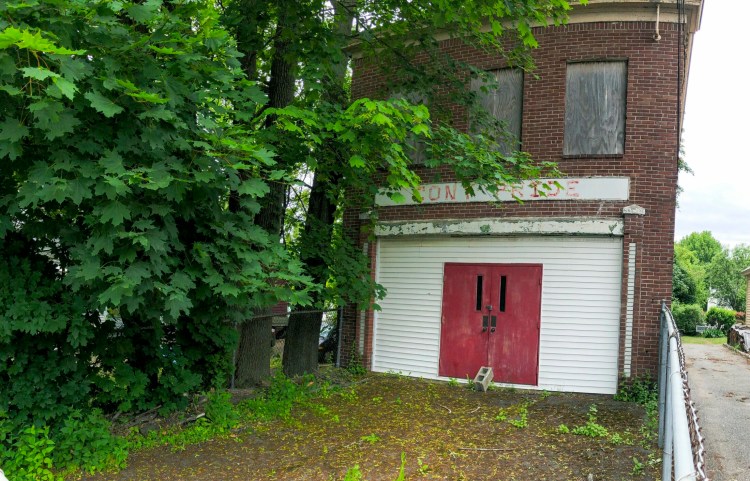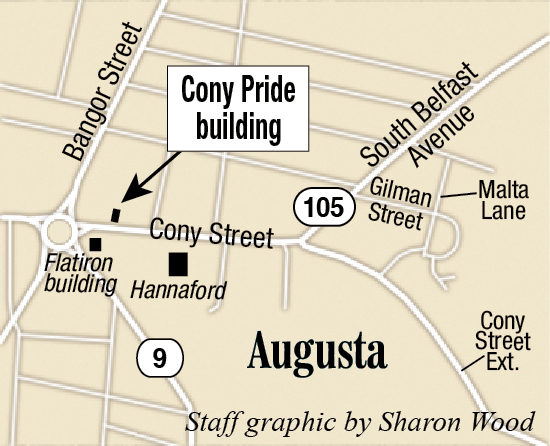AUGUSTA — City councilors agreed Thursday the city should seek a new owner for the old Cony Pride building, even if it means that owner could tear down the building that hosted Cony High School student activities for many years.
The small building has been vacant in recent years and would need major structural repair and updates to be put back into use, city officials said. But councilors agreed informally Thursday the city should see if anyone might be interested in buying the building and either renovating it or demolishing it to make new use of the 2,500-square-foot lot on which it sits at 111 Cony St.
“I think we should market it,” said Ward 1 Councilor Linda Conti. “I know it’s small. But we don’t know what people might do until we put it on the market and see what happens.”
A review of the structural integrity of the vacant building commissioned by the city earlier this year deemed it to be in poor condition and in need of structural stabilizing before it could be put back into use.
Ward 4 Councilor Eric Lind said he heard from one constituent who said the city should take better care of its buildings, particularly historic ones like the Cony Pride structure, which originally was a fire substation used by the Atlantic Hose Co.
Matt Nazar, development director, said the building, after it was no longer used as a fire station, was turned over to the school system. For decades it was used by Cony High School, when the school was still located across the street.
He said when the city got the building back from the School Department after a new Cony High School was built on Pierce Drive, it was already structurally deficient, had a hole in the roof and had other major problems. He said when the city got the building back, city councilors at the time were focused on what would become of the much-larger, old Cony flatiron building, which has since been converted into senior housing, than they were about the small Cony Pride building.
“It was in very poor condition when we got it back,” Nazar said. “We secured it but it has continued to deteriorate in the 15 years we’ve had it.”
Nazar said the city has owned the property since 1866, when it was deeded to the city, to be the site of a fire station, from the Lithgow and Baker families. Llewellyn Lithgow also left a $20,000 bequest to the city for the purpose of building a public library, which was built following additional fundraising and opened in 1896, bearing the name Lithgow Public Library.
While it is unclear when the brick building was built on the Cony Street site, city assessing records indicate it was constructed around 1900.
Stabilizing the 26-foot-wide building, which sits on a roughly 26-foot-wide lot, would cost an estimated $132,000. That includes the expense of framing and foundation repairs, a new roof to replace the currently leaky roof and removal of debris and hazardous materials.
But it does not include the cost of other upgrades, such as new windows, doors, plumbing, heating or any internal renovation. Because the walls are so close to the property line, there is no practical or safe on-site parking on the lot, according to Nazar.
Demolishing the 111 Cony St. building, meanwhile, would likely cost about $30,000, and would leave the city with a vacant, 26-by-98-foot lot.
Because the building is more than 50 years old, any owner wishing to demolish it, including the city, would have to have the city’s Historic Preservation Commission review the building’s potential historical significance. If the building is deemed historically significant, the process could trigger a 90-day demolition delay requirement. After that time period, the owner could demolish the building.
City Manager William Bridgeo said neighbors of the site have expressed concern about its condition and appearance, and want the city to do something about it.
He also said the owner of an abutting property, local businessman Gary Violette, has expressed interest in potentially buying the lot, demolishing the building and the house on his abutting lot, and building a new apartment building on the combined lot.
Bridgeo said Violette was going to work with an engineer to determine whether such a project could be built in a way to comply with the city’s land use standards. Bridgeo said he has not yet heard back.
Bridgeo said if the city were to sell the property, he would recommend requiring the new owner to do something with the building, either fix it up or demolish it, within a certain amount of time so the property does not remain in disrepair.
He said the city could seek proposals for the building, with the provision councilors could reject any offer submitted.
Send questions/comments to the editors.





Comments are no longer available on this story